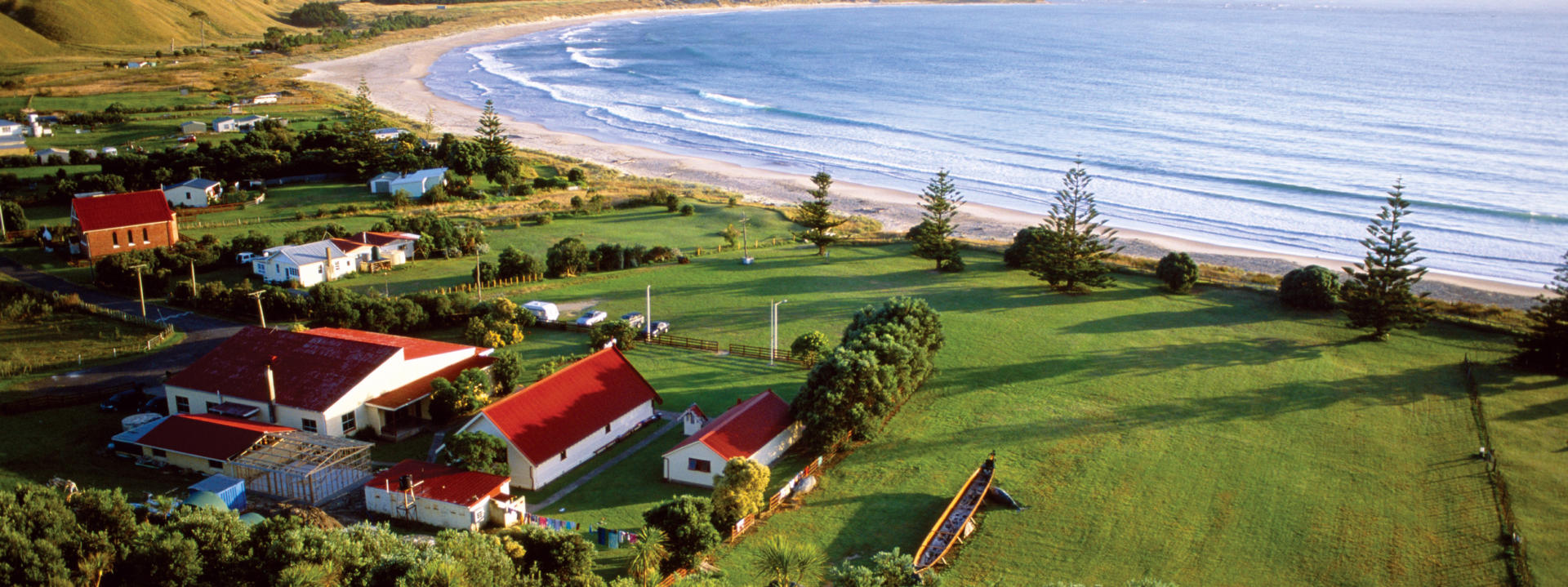
The Gisborne region, also commonly referred to as the East Coast or by the Maori name Te Tai Rawhiti, is New Zealand’s eastern-most region. Its coastline extends from Cape Runaway in the north, out around East Cape and southward to the southern end of Poverty Bay, a distance of approximately 250 km. The Maori name for the district translates to Coast of the Sunrise, a hint to the fact that this is the first major landmass in the world to see the dawn of each new day. It was also the first part of New Zealand to be sighted and subsequently set foot upon by Captain James Cook during his voyage southward in 1769 in search of a rumoured great southern land. The region’s interior is rugged and dominated by the Raukumara Range that rises to 1752 m at the summit of Mt Hikurangi, the fifth highest peak in the North Island. The only significant flat land lies in the south and is used for horticultural and viticultural production.

The climate is temperate oceanic with high sunshine hours and moderate rainfall. Temperatures generally remain above 10 degrees in winter and around 20 in the summer. While snow fall occurs inland during the winter, temperatures rarely fall far below zero or above 30 degrees in the summer months. With a relatively sparse population of just 49,000 – 37,000 of whom live in Gisborne city itself – the region offers a unique glimpse into the isolated rural extremities of New Zealand for independent travellers with sufficient time to travel this way. The entire region accounts for only one percent of national GDP and no settlement outside of Gisborne city has a population of more than 1000 people. 45% of the population are Maori, three times the national percentage, and less than 10% of the population were born abroad compared to 25% nationally.
One of New Zealand’s four cardinally named capes, East Cape is reached via a rewarding 20 km side trip from SH35. Those travelling by motorhome benefit from the opportunity to freedom camp at the road end and rise sufficiently early the following morning to be among the very first people on the planet to witness the sun rise above the horizon and warm the land with the rays of a new day. The lighthouse here is as photogenic as any, standing guard over the surrounding remote coastline. The settlement of Te Araroa, at the junction with SH35, is the hometown of Sir Apirana Ngata who holds a special place in the country’s history as a leading statesman. Nurtured from a young age by senior members of the community, in 1896 he became the first Maori to graduate from university when he achieved a law degree. He was elected as a Member of Parliament in 1905 and served continuously for 38 years. His knowledge of the Pakeha world made an important contribution to the revival of Maori in a rapidly changing post-colonial world, and he is remembered on our $50 note for his efforts. The nearby settlement of Tikitiki is renown for its non-denominational St Mary’s church that features a wonderful blend of Maori and Pakeha influence in its architecture and interior.
The SH35 route that follows the full length of the Gisborne region’s eastern extremity offers a wonderful opportunity to experience a sparsely populated rural extremity of New Zealand for those travelling on leisurely itineraries. The route forms part of the Pacific Coast Highway and passes through many areas of interest, taking 330 km to travel from Gisborne city to eventually reach Tauranga in the neighbouring Bay of Plenty region. Tolaga Bay (believed to be a corruption of an unknown Maori word) is located 53 km north of Gisborne and represents one of only two settlements along the route to even come close to having 1000 inhabitants. The beach here is dominated by the landmark of a 600 m wharf that was last used for commercial shipping in the 1960s. A pleasant walk to nearby Cook’s Cove provides great views of the coast. Midway between Tolaga Bay and Gisborne, a side road takes curious travellers to the tiny seaside village of Whangara, where the highly acclaimed 2002 movie Whale Rider was filmed, earning 13 year old Keisha Castle-Hughes the distinction of becoming the youngest nominee for an Academy Award at the time.
The city of Gisborne is named after an early Colonial Secretary (a role that served as deputy to the country’s successive titles of Governor, Premier and eventually Prime Minister until 1907). The city is located on the shores of Poverty Bay that marks the southern end of the Gisborne region. The population of 38,000 has remained almost unchanged for more than 30 years. Renown for sunny weather and fine beaches, Gisborne revels in its relative isolation from the rest of the North Island, its reputation as the first city in the world to see the dawn of each new day, and its image as a surfers’ paradise. Kaiti Beach, close to the current town centre, was where Captain James Cook first set foot upon New Zealand in 1769. Faced with indigenous locals who were deeply suspicious of outsiders by nature – let alone visitors who bore white skin and might as well have arrived by UFO – the initial encounter did not go entirely smoothly and resulted in the deaths of several local Maori. Having originally intended to name the bay in honour of his vessel the Endeavour, he instead opted for Poverty Bay after failing to secure the hoped for supplies for his crew. Poverty Bay’s southern extremity of Young Nick’s Head takes its name from Cook’s crew member who first sighted it. Although Cook’s visit to the area marked the first time that Europeans had landed, the country had previously been visited by Dutch explorer Abel Tasman in 1642. These days the name Poverty Bay is commonly used to refer to the greater area surrounding Gisborne city and is home to several successful wineries. Gisborne’s centrally located Kaiti Hill can easily be negotiated in your motorhome and affords superb views from Cook’s Monument out over the town centre, shipping and fishing port, and the wider area. The city is also home to one of the country’s best small museums. The 2014 movie The Dark Horse, about a local young chess genius, was filmed in Gisborne and received high praise at film festivals around the world. Nearby Gisborne, a 30 minute drive through pleasant countryside to the north-west brings adventurous green-fingered explorers to the Eastwoodhill National Arboretum.